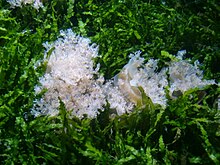Cassiopea
| Cassiopea | |
|---|---|

| |
| Cassiopea sp. | |
| Scientific classification | |
| Domain: | Eukaryota |
| Kingdom: | Animalia |
| Phylum: | Cnidaria |
| Class: | Scyphozoa |
| Order: | Rhizostomeae |
| Family: | Cassiopeidae Agassiz, 1862 |
| Genus: | Cassiopea Péron & Lesueur, 1809 |
| Species | |
|
8 species, see text | |
| Synonyms | |

Cassiopea (upside-down jellyfish) is a genus of true jellyfish and members of the family Cassiopeidae.[3] They are found in warmer coastal regions around the world, including shallow mangrove swamps, mudflats, canals, and turtle grass flats in Florida, the Caribbean and Micronesia. The medusa usually lives upside-down on the sea floor in shallow areas, which has earned them their common name. These jellyfish partake in a symbiotic relationship with photosynthetic dinoflagellates and therefore, must lie upside-down in areas with sufficient light penetration to fuel their energy source.[4] Where found, there may be numerous individuals with varying shades of white, blue, green and brown.
Species
[edit]According to the World Register of Marine Species, this genus includes 8 species:[5]
- Cassiopea andromeda (Forsskål, 1775)—Indo-Pacific, introduced in the Mediterranean
- Cassiopea depressa Haeckel, 1880—Western Indian Ocean off the African coast
- Cassiopea frondosa (Pallas, 1774)—Western Atlantic, Caribbean Sea
- Cassiopea maremetens Gershwin, Zeidler & Davie, 2010—Western Pacific Ocean, off the Australian Coast
- Cassiopea medusa Light, 1914—Pacific Ocean, Philippines and Palau Region
- Cassiopea mertensi Brandt, 1838—Pacific Ocean Southern Micronesia
- Cassiopea ndrosia Agassiz & Mayer, 1899—Pacific Ocean, Australia and Fiji
- Cassiopea ornata Haeckel, 1880—Pacific Ocean, Palau, Philippines, Okinawa
- Cassiopea xamachana Bigelow, 1892—Caribbean Sea and the Northern Atlantic Area of the West indies
Defense system
[edit]Cassiopea species have a mild sting since they are primarily photosynthetic, but sensitive individuals may have a stronger reaction. The photosynthesis occurs because, like most corals, they host zooxanthellae in their tissues.[6] The stinging cells are also found in cellular masses, dubbed "cassiosomes", excreted in a mucus; people swimming near the jellyfish may come in contact with these cassiosomes and be stung.[7][8] The stings, appearing in the form of a red rash-like skin irritation, are known for being extraordinarily itchy. Sometimes this jellyfish is picked up by the crab Dorippe frascone and carried on its back[citation needed]. The crab uses the jellyfish to defend itself against possible predators.
Behavior
[edit]Certain species of Cassiopea have been observed to enter a sleep state - exhibiting decreased pulsation rate, reduced responsiveness to stimuli, and compensatory rebound sleep after deprivation.[9] They are the first animals with no central nervous system to have been observed sleeping.[10]

References
[edit]- ^ IRMNG (2021). Cassiopeia Gistl, 1848. Accessed on 2023-05-29.
- ^ IRMNG (2021). Cassiopeja Schultze, 1898. Accessed on 2023-05-29.
- ^ "Cassiopeidae". WoRMS. World Register of Marine Species. Retrieved 3 August 2012.
- ^ Ohdera Aki H.; Abrams Michael J.; Ames Cheryl L.; Baker David M.; Suescún-Bolívar Luis P.; Collins Allen G.; Freeman Christopher J.; Gamero-Mora Edgar; Goulet Tamar L.; Hofmann Dietrich K.; Jaimes-Becerra Adrian; Long Paul F.; Marques Antonio C.; Miller Laura A.; Mydlarz Laura D.; Morandini Andre C.; Newkirk Casandra R.; Putri Sastia P.; Samson Julia E.; Stampar Sérgio N.; Steinworth Bailey; Templeman Michelle; Thomé Patricia E.; Vlok Marli; Woodley Cheryl M.; Wong Jane C.Y.; Martindale Mark Q.; Fitt William K.; Medina Mónica (2018). "Upside-Down but Headed in the Right Direction: Review of the Highly Versatile Cassiopea xamachana System". Frontiers in Ecology and Evolution. 6: 35. doi:10.3389/fevo.2018.00035. hdl:11449/176281.
- ^ "Cassiopea". WoRMS. World Register of Marine Species. Retrieved 3 August 2012.
- ^ Murphy, Richard C. (2002). Coral Reefs: Cities Under The Sea. Princeton, New Jersey: The Darwin Press. ISBN 978-0-87850-138-0.
- ^ Ames, Cheryl L.; Klompen, Anna M. L.; Badhiwala, Krishna; Muffett, Kade; Reft, Abigail J.; Kumar, Mehr; Janssen, Jennie D.; Schultzhaus, Janna N.; Field, Lauren D.; Muroski, Megan E.; Bezio, Nick (2020-02-13). "Cassiosomes are stinging-cell structures in the mucus of the upside-down jellyfish Cassiopea xamachana". Communications Biology. 3 (1): 67. doi:10.1038/s42003-020-0777-8. ISSN 2399-3642. PMC 7018847. PMID 32054971.
- ^ "Stinging water mystery solved: Jellyfish can sting swimmers, prey with 'mucus grenades'". Phys.org. February 13, 2020. Retrieved February 14, 2020.
- ^ "The surprising, ancient behavior of jellyfish". EurekAlert. Retrieved 22 September 2017.
- ^ "The Jellyfish Cassiopea Exhibits a Sleep-like State". Current biology. 2017.
